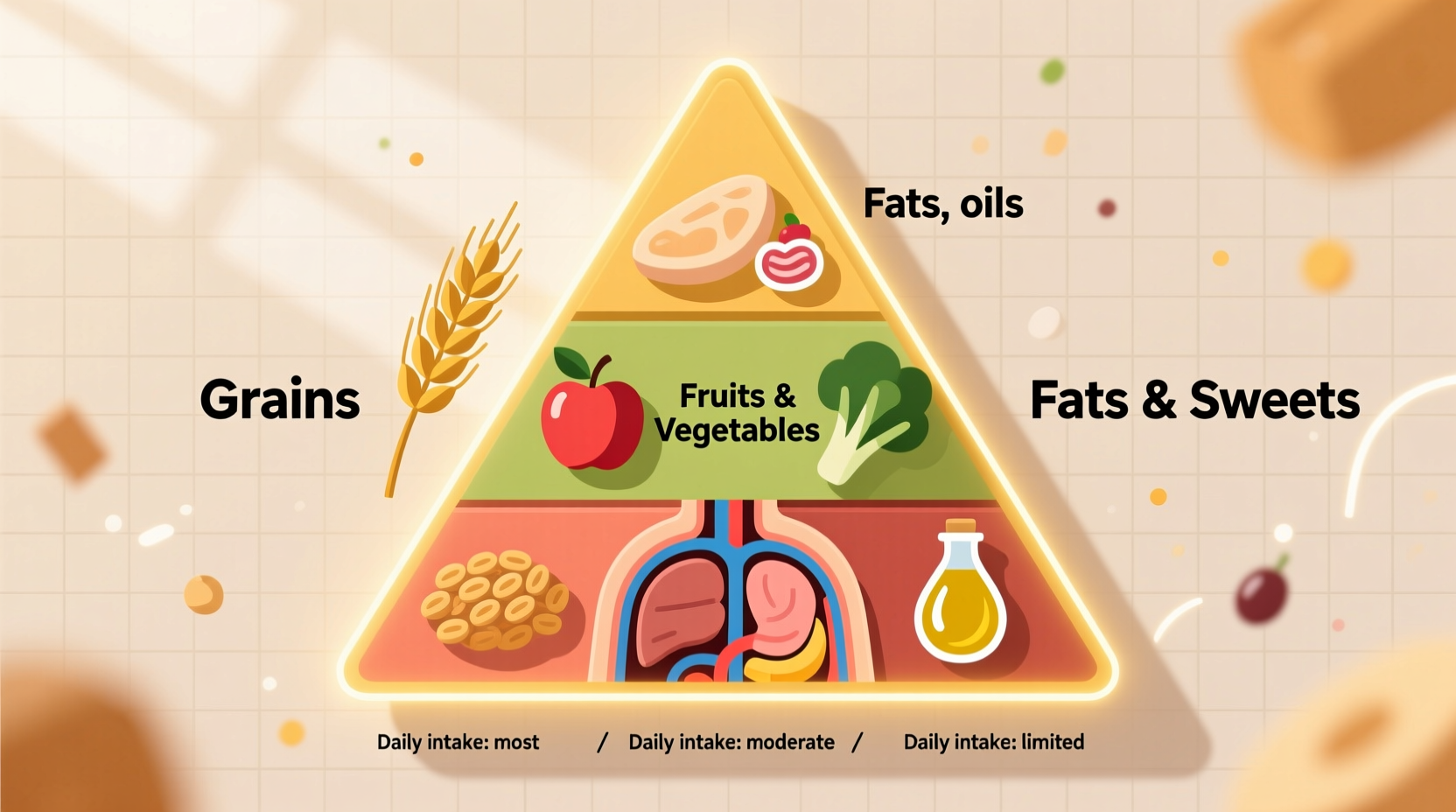Understanding this foundational dietary framework helps clarify how nutritional guidance has evolved to support healthier eating habits. The food triangle provided clear visual hierarchy for meal planning, emphasizing proportionality long before modern MyPlate recommendations.
Decoding the Food Triangle Structure
Developed in the late 1970s and widely adopted through the 1980s, the food triangle represented one of the first standardized visual tools for public nutrition education. Unlike today's circular or plate-based models, this triangular format conveyed nutritional hierarchy through spatial arrangement:
- Base layer (largest section): Carbohydrate-rich foods like bread, rice, and pasta—recommended for most frequent consumption
- Middle section: Protein sources including meat, fish, eggs, and dairy products—moderate daily portions
- Apex (smallest section): Fats, oils, and sweets—minimal consumption
This geometric approach helped consumers visualize portion proportions without complex measurements. The Swedish National Food Administration first introduced this model in 1974, with many European countries adapting it throughout the following decade.

Evolution of Dietary Guidance Systems
Nutrition visualization tools have undergone significant transformation since the mid-20th century. The food triangle represented a critical transition point between early food group lists and today's sophisticated dietary models:
| Era | Primary Model | Key Characteristics |
|---|---|---|
| 1940s-1960s | Basic Food Groups | Four groups (milk, meat, fruits/vegetables, grains) without proportional guidance |
| 1970s-1980s | Food Triangle | Geometric hierarchy showing consumption proportions, first widespread visual model |
| 1992-2011 | Food Pyramid | Vertical layers with serving recommendations, introduced by USDA |
| 2011-Present | MyPlate | Plate-based model emphasizing portion distribution during meals |
The food triangle's greatest contribution was establishing the principle that visual proportionality matters in dietary guidance. However, it faced criticism for oversimplifying complex nutritional needs and lacking specific serving size recommendations. By 1992, the USDA replaced it with the food pyramid, which added vertical layers and specific daily servings.
Practical Applications for Modern Eating
While no longer the official dietary model, the food triangle's core principles remain relevant for contemporary nutrition planning. Its emphasis on proportionality translates directly to current healthy eating practices:
When constructing meals today, consider applying the triangle's foundational concept: fill half your plate with vegetables and fruits (modern equivalent of the base), one-quarter with lean proteins (middle section), and one-quarter with whole grains (refined base layer). This simple visual approach helps maintain balanced nutrition without calorie counting.
Nutrition educators still reference the food triangle when explaining dietary evolution to students. Understanding this historical model provides context for appreciating current guidelines' sophistication while recognizing that proportionality remains nutrition's cornerstone principle.
Common Misunderstandings Clarified
Several misconceptions persist about the food triangle that deserve clarification:
- It didn't specify exact portions: Unlike later models, it showed relative proportions rather than precise serving sizes
- It wasn't universally standardized: Different countries implemented variations with regional food adaptations
- It didn't ignore vegetables: Many implementations included produce within the carbohydrate base layer
- It wasn't replaced due to inaccuracy: The food pyramid offered more detailed guidance as nutritional science advanced
The Swedish Food Agency's historical documentation confirms that the triangle model successfully reduced nutrition-related health issues during its implementation period, particularly in addressing vitamin deficiencies through clearer food group representation.
Enduring Legacy in Nutrition Education
The food triangle's influence persists in today's dietary recommendations despite its official retirement. Modern nutritionists recognize its role in establishing visual dietary guidance as an effective public health tool. Current models maintain its core principle: not all food groups deserve equal plate space.
When examining historical nutrition resources, recognizing the food triangle helps contextualize dietary advice from the 1980s and early 1990s. This understanding proves valuable for nutrition students, historians, and anyone analyzing older dietary literature. The model's simplicity made nutritional guidance accessible to broader audiences, paving the way for today's more sophisticated but equally visual approaches.
Frequently Asked Questions
What was the main purpose of the food triangle model?
The food triangle's primary purpose was to provide a simple visual representation of balanced eating proportions, showing that carbohydrate-rich foods should form the largest part of daily consumption, proteins a moderate portion, and fats/sugars only minimal amounts. This geometric approach made nutritional guidance more accessible to the general public than previous text-based recommendations.
How did the food triangle differ from the food pyramid?
The food triangle used horizontal layers in a triangular format to show consumption proportions without specific serving sizes, while the food pyramid introduced vertical sections with recommended daily servings. The pyramid also separated vegetables and fruits into distinct groups and included more detailed guidance on fats and oils placement. The triangular model focused on relative proportions, whereas the pyramid provided more precise quantitative recommendations.
Why was the food triangle replaced by other models?
The food triangle was replaced because it lacked specific serving size recommendations and couldn't adequately represent the growing understanding of nutritional science. As research revealed more about micronutrients, fiber, and healthy fats, more sophisticated models were needed. The USDA introduced the food pyramid in 1992 to provide clearer portion guidance and better reflect emerging nutritional knowledge about balanced diets.
Is the food triangle still used anywhere today?
While no country uses the food triangle as its primary dietary guidance model, some educational programs reference it when teaching nutrition history. Certain specialized dietary approaches for specific populations occasionally adapt triangular formats for simplicity. Nutrition educators sometimes use the concept when explaining dietary evolution to students, as it represents an important transitional model between early food group systems and modern visual guidance tools.
How can I apply food triangle principles to modern eating?
You can apply the food triangle's core principle of proportionality by visualizing your plate with carbohydrates (preferably whole grains) forming the largest section, proteins occupying a moderate portion, and fats used sparingly. Modern interpretations suggest filling half your plate with vegetables, one-quarter with lean protein, and one-quarter with whole grains—essentially updating the triangle's hierarchy for contemporary nutritional understanding while maintaining its fundamental proportionality concept.











 浙公网安备
33010002000092号
浙公网安备
33010002000092号 浙B2-20120091-4
浙B2-20120091-4